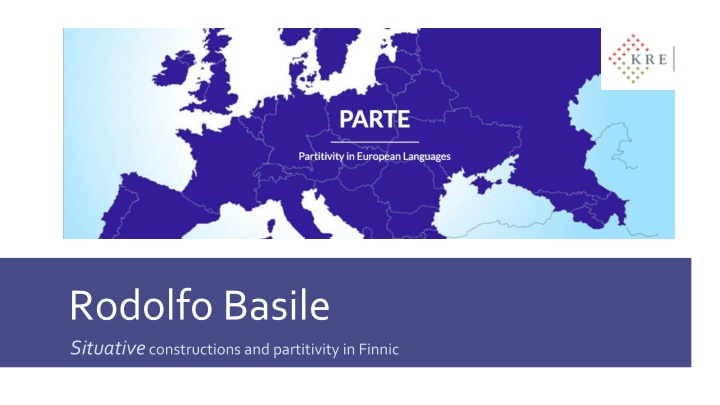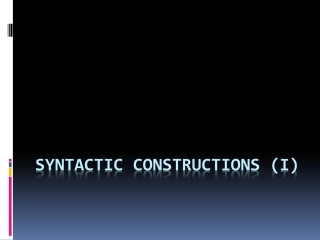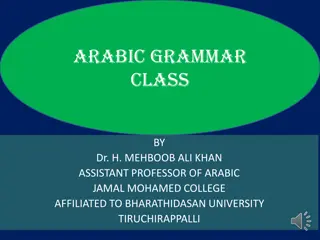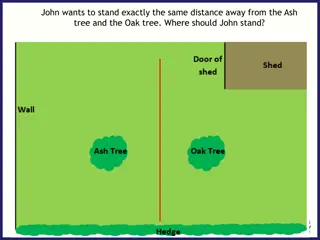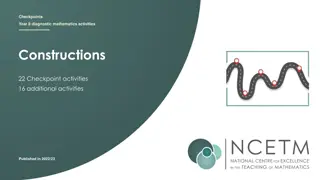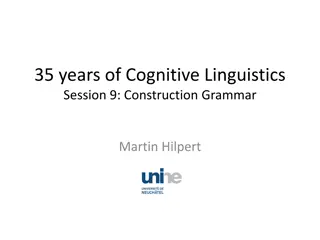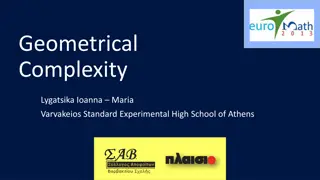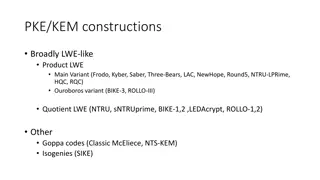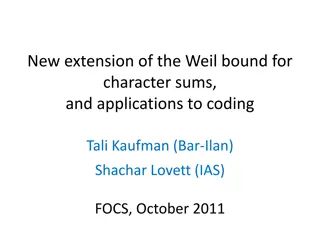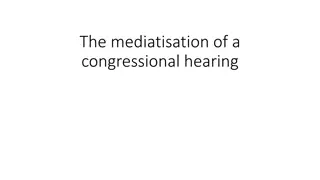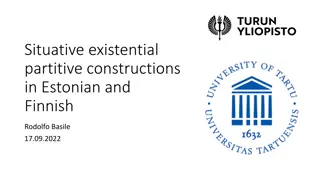Situative Constructions and Partitivity in Finnic: Rodolfo Basile Analysis
Investigating situative constructions and partitivity in the Finnic languages, Rodolfo Basile explores non-prototypical locational constructions. Hypothesizing lexical existentials in Finnics as existential constructions, the study delves into unique subject variances. Basile's forthcoming works delve into situative strategies and collostructional analyses of Finnish partitive constructions, offering insights into spatial relations and locational predications in European languages.
Download Presentation

Please find below an Image/Link to download the presentation.
The content on the website is provided AS IS for your information and personal use only. It may not be sold, licensed, or shared on other websites without obtaining consent from the author.If you encounter any issues during the download, it is possible that the publisher has removed the file from their server.
You are allowed to download the files provided on this website for personal or commercial use, subject to the condition that they are used lawfully. All files are the property of their respective owners.
The content on the website is provided AS IS for your information and personal use only. It may not be sold, licensed, or shared on other websites without obtaining consent from the author.
E N D
Presentation Transcript
Rodolfo Basile Situative constructions and partitivity in Finnic
Situative constructions and partitivity in Finnic Rodolfo Basile University of Tartu, University of Turku
Theorization of situative constructions, a semantically non- prototypical class of locational constructions Overview of non-prototypical subjects in Finnic Main points What are lexical existentials? Hypothesis: in Finnic, situative verbs may be considered existential constructions par excellence (lexical existentials in the strict sense ) because they can be often replaced by the copula
Basile, Rodolfo. Forthcoming. Situative constructions in European languages.SLE2021 Book of Abstracts. Basile, constructionsinEuropeanlanguages. Rodolfo. Forthcoming A. Situative strategies and Basile, Rodolfo. Forthcoming B. Two collostructional analysis accountsofthe FinnishPartitiveE-NPconstruction. Contributions Basile, Rodolfo, and Ilmari Ivaska. Forthcoming (June 2021). L yty - verbin konstruktioiden yhteydess Journalof EstonianandFinno-UgricLinguistics. esiintyv subjektivaihtelu.
A spatial relation of a Figure located in/on a Ground or in motion towards/from it (Creissels 2009) Locational predication Prototypical in European languages Figure = theme; Ground = rheme Non-prototypical: existential constructions, inverse-locational predication (Creissels 2014, 2019); presentational constructions (Gast & Haas 2011)
Russian (East Slavic) [Partee & Borschev 2008: 147 adapted] a. Doktor byl v gorode doctor.NOM.M.SG was.M.SG in town Existential constructions The doctor was in town. b. V gorode byl doktor in town was.M.SG doctor.NOM.M.SG There was a doctor in town.
French Romance [Creissels 2014] Il y a Jean qui veut Presentational constructions it.EXPL there.EXPL has Jean who wants parler te to_you talk (*There is) Jean (who) wants to talk to you.
Semantically non-prototypical locational constructions They predicate where a referent situates itself (Basile, forthcoming A) Situatives Semantically complex predicate Not a copula, but with a copula-like meaning on a construction level Morphologically marked (reflexive derivation)
Italian (Romance) pers.knowl. Mi trov-avo in una situazione REFL.1SG find-PST.IPFV.1SG in a.FEM situation orribile horrible Situatives I found (Iwas finding)myselfina horrible situation. L Italia si trov-a nel Mediterraneo the.Italy REFL.3 find-3SG in.the Mediterranean.sea Italyissituated inthe Mediterranean.
Norwegian Bokml(WestScandinavian) [Glosbe] Arten finne-s i Myanmar specie.DET find-MPAS in M. Thespecie is foundinMyanmar. Situatives Polish(WestSlavic) [Glosbe-OpenSubtitles2018.v3] Znajduje-my si na wodach Florydy find-1PL on water.LOCFlorida.GEN REFL WeareinFlorida waters.
Two semantic categories: FINDER and FOUND Semantic approach FINDER point of view over the situative, hypothetical agent causing the (fictive) process that precedes the finding FOUND patient of the (fictive) process
German (West Germanic) Glosbe Der Bahnhof befindet sich zwischen diesen beiden the station locate.3SG between these two REFL Situatives type I St dten cities The station islocatedbetween these two cities.
Modern Greek [Glosbe- OpenSubtitles2018.v3] , Situatives type II agapit mit ra, vr sk-o-mai an mesa se l kous dear.voc mother.VOC find-1SG-MPAS between to wolf.ACC.PL Dear mother, Ifindmyselfamong wolves.
Reflexive markers are used in coexpression patterns They can occur in different functions, usually: Coexpression patterns - reflexive - reciprocal - impersonal - other
Italian (Romance) pers.knowl. a. Marco si lava M. wash.3SG REFL Marco washes himself. b. Qua si mangia bene Coexpression patterns here eat.3SG well REFL Here one eats well. c. Si odiano a morte hate.3PL to death REFL They hate each other to death. d. Marco si mangia un gelato M. eat.3SG a ice.cream REFL Marco is eating/going to eat ice cream. (Medio-transitive, Masini 2012)
Spanish(Romance) - Glosbe El hotel se encuentra en una zona the hotel find.3SG in a area REFL Situatives type III tranquila calm The hotel islocated ina calmarea.
Estonian (Finnic) [etTenTen Web 2019] Metsa all leid-u-b kukeseeni ja forest.GEN under find-REFL-3SG chanterelle.PAR.PL and metsamaasikaid wild.strawberry.PAR.PL Situatives in Finnic There are chanterelles andwildstrawberries onthe forestfloor. Finnish (Finnic) (Basile & Ivaska,forthcoming) Erojakin toki l yt-y-y difference.PL.PAR.ENCL certainly find-REFL-3SG There are certainly differences, too.
Type I (external FINDER) Situatives in Finnic Usually only in 3. person Both with concrete and abstract locations
In Finnish and Estonian, a dedicated partitive grammatical case can express many functions (Huumo 2010, Ser ant 2021) Partitives can alternate with the so-called totalitiivi, a term which includes total objects in genitive or nominative plural (syncretic accusative, Ser ant 2021), or nominative objects in constructions, as well as prototypical subjects in nominative (Larjavaara 2019) Partitive subjects in Finnic The subjecthood of partitives is debatable both semantically and morphosyntactically speaking Associated with existential constructions (Hakanen 1972; Huumo & Lindstr m 2014) e-NP (Huumo & Helasvuo 2015; see also Helasvuo 1996, Metslang 2014)
Lexical existentials (Larjavaara 2019) are those (intransitive) verbs that: are different from copulas can appear in a construction featuring an e-NP predicate the existence of something, as well as what it is doing Lexical existentials Finnish kadulla juokse-e koir-ia street.ADE run-3SG dog-PL.PAR There are dogs running on the street
Basile (forthcoming B) compares the usage of ten different lexical existentials with e-NPs in Finnish web corpora Method: Collostructional analysis (Stefanowitsch & Gries 2003; Gries & Stefanowitsch 2004; Gries 2019), based on Construction grammar (Goldberg 1995) Some turned out to be more strongly associated to existential constructions than others: l yty to be found was at the first place (then mahtua to fit , sataa to rain , and riitt to suffice ) probably not a casual phenomenon! Lexical existentials in the strict sense These verbs (except for to rain ) semantically often behave in a way very close to the prototypical existential olla to be , and can hence be considered lexical existentialsin the strict sense ruoka-a riitti food-PAR suffice.PST.3SG There was (a lot of) food.
Finnish [Basile & Ivaska, forthcoming] Tuotte-et/-ita l ytyy my s rannasta product-NOM.PL/PAR.PL find.REFL.3SG also beach.ELA Products are found also on the beach. Nom-Par alternation The nominative case (prototypical subject) gives the predicate a more prototypical reading -> does not work well with a copula *tuotteet on rannassa The partitive case gives an existential reading what happens if the word order is flipped? Rannasta l ytyy my s tuotteita beach.ELA find.REFL.3SG also product.PAR.PL Does it work better with a copula instead?
Miss se on? Eiku l yty(i)! Tense where it.NOM is ?DM find.IMP.3SG Where is it? Wait, found!
In Finnic, situative constructions may feature partitive e-NPs instead of canonical subjects Situatives may overlap with existential constructions and situative verbs can be considered lexical existentials in the strict sense Conclusions This overlapping corroborates the idea according to which situatives express, on a clause-semantic level, the same meaning as the copula to be in prototypical locational constructions The partitive e-NP in situative constructions helps forgetting the prototypical meaning of the predicate ( to be found )
Basile, Rodolfo.Forthcoming A.Situativestrategies and constructions in European languages. Basile, Rodolfo. Forthcoming B. Two collostructional analysis accounts of the Finnish Partitive E-NP construction. Basile, Rodolfo, and Ilmari Ivaska. L yty -verbin konstruktioiden yhteydess esiintyv subjektivaihtelu. Journal of Estonianand Finno-Ugric Linguistics. Creissels, Denis. 2009. Spatialcases.TheOxford handbook of case,609-625. Creissels, Denis. 2014. ExistentialPredication in Typological Perspective. Ms., Universit Lyon. References Creissels, Denis. 2019. Inverse-Locational Predication in Typological Perspective. Italian Journal of Linguistics31 (2): 38 106. Gast,Volker, and Florian Haas. 2011. On thedistribution of subject properties in formulaic presentationals of Germanic and Romance (pp. 127-166). Amsterdam: John Benjamins Publishing. Goldberg, Adele E. 1995. Constructions: A construction grammar approach to argument structure. Universityof Chicago Press. Gries, Stefan Th.2019. 15 years of collostructions: some long overdue additions/corrections (to/of actually all sorts ofcorpus-linguistics measures). International Journal of Corpus Linguistics24 (3): 385 412.
Gries, Stefan Th., and Anatol Stefanowitsch. 2004. Extending collostructional analysis: A corpus-based perspective on `alternations. International JournalofCorpus Linguistics 9 (1): 97 129 Hakanen,Aimo. 1972. NormaalilauseJaEksistentiaalilause. Sananjalka14(1): 36 76. https://doi.org/10.30673/sja.86366. Helasvuo,Marja-Liisa.1996. Ollako VaiEik Olla-Eksistentiaalilauseen Subjektin Kohtalonkysymys. Viritt j 100(3): 340 340. Huumo,Tuomas.2010.Nominalaspect, quantity, andtime: Thecase oftheFinnish object. JournalofLinguistics, 83-125. Huumo,Tuomas,andMarja-LiisaHelasvuo.2015.On theSubject ofSubject in Finnish.SubjectsinConstructions CanonicalandNon-Canonical,13 41. Huumo, Tuomas, and Liina Lindstr m. 2014. Partitives across Constructions: On the Range of Uses of the Finnish and Estonian Partitive Subjects . PartitiveCases andRelatedCategories 54:153. References Larjavaara,Matti.2019. PartitiivinValinta.Suomalaisen Kirjallisuuden Seura. Masini,Francesca.2012. CostruzioniVerbo-Pronominali Intensive in Italiano.Language andtheBrain Semantics. Metslang,Helena. 2012.On theCase-MarkingofExistential Subjects in Estonian.SKYJournalofLinguistics 25: 151 204. Partee, Barbara H., and Vladimir Borschev. 2008. Existential Sentences, BE, and the Genitive of Negation in Russian. Existence: Semantics and Syntax, 147 90.Springer. Ser ant, Ilja A.2021. Typologyofpartitives. Linguistics. Stefanowitsch, Anatol, and Stefan Th Gries. 2003. Collostructions: Investigating the interaction of words and constructions. International Journal of Corpus Linguistics 8(2): 209 43.
ACKNOWLEDGEMENTS THE STUDY HAS BEEN SUPPORTED BY MORPHOSYNTACTIC AND PHONOLOGICAL ASPECTS OF FINNO-UGRIC LANGUAGES (MOBILITY PROJECT NKM-66/2019 BETWEEN THE HUNGARIAN ACADEMY OF SCIENCES AND THE ESTONIAN ACADEMY OF SCIENCES), THE EUROPEAN REGIONAL DEVELOPMENT FUND, AND THE FINNISH NATIONAL AGENCY FOR EDUCATION. 27
